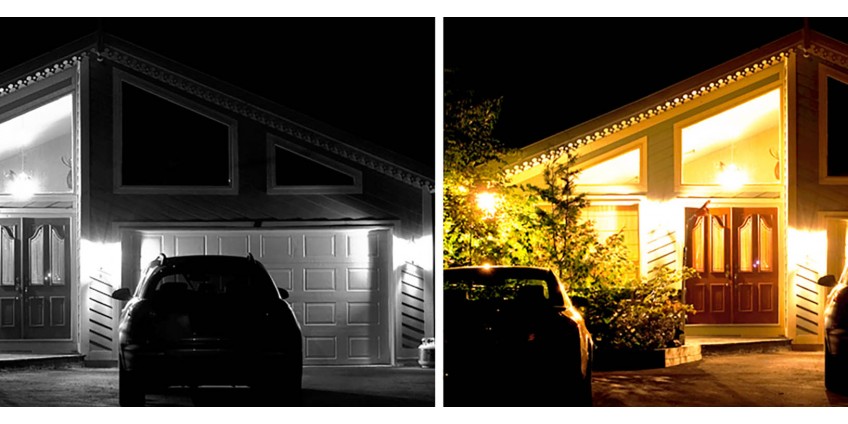
This product is not exportable outside the United States.
By adding this item to cart, you agree and acknowledge the Export Policy and confirm that you are a person in the United States with no intentions to illegally export the device.
This product is not exportable outside the United States.
By adding this item to cart, you agree and acknowledge the Export Policy and confirm that you are a person in the United States with no intentions to illegally export the device.


0

0


Starting to talk about color night vision, it is necessary to outline the very principle of night vision devices in a few words. We cannot see in the dark. This is undeniable. And this is not always due to a complete absence of light, given that our eye only sees a narrow band of the light spectrum, from red to violet. Everything outside this range is invisible to us. At the same time, in absolute darkness, without special infrared illumination, even the most expensive device is "blind." And only thanks to the night vision system is infrared converted into visible color. As a rule, green is the most sensitive wavelength to our eyes. At the same time, at minimum light, the device amplifies already existing light many times, up to a value sufficient for perception by the naked eye. It is simple, the light reflected from the object falls on the entrance lens of the optical system, from where this image is focused on the electro-optical converter, where after amplifying the incoming light stream several thousand times, the idea is transmitted to the luminescent screen. This is passive amplification of the luminous flux.
There is a strong opinion that the full-color night vision improves the old technology working in minimal light or starlight. In other words, the night vision system controls the light level, and when it becomes too low for color video, infrared lighting is turned on. Scientists at the University of California, Irvine, have demonstrated the concept of full-color night vision using artificial intelligence. Using infrared light, they could colorize several images into "full-color," which opened up new possibilities in a variety of industries. The researchers created the basis for full-color night vision. In normal light, white light has many colors mixed in. When light falls on something, it absorbs some colors and reflects others. Thus, a pure red object reflects red and absorbs other colors. Although some systems work by amplifying small amounts of light, they do not work in total darkness. They require night vision devices that illuminate the scene with infrared light. Scientists have suggested that different objects can absorb different kinds of infrared light. Teaching the system what colors correspond to specific absorption characteristics allows the computer to reconstruct the image's color.
A digital night vision device consists of a lens, a light-sensitive sensor, image processing and control electronics, a display, and an eyepiece. The power supply of digital devices The devices are usually equipped with built-in infrared illuminators based on laser or LED sources.
Unlike black and white, the resolution of color sensors is up to forty percent lower, which is due to the complex pixel system, where one pixel of a color sensor consists of several subpixels, each of which is responsible for a strictly defined light spectrum - red, blue, green. In other words, when monochromatic light hits a color camera pixel, only one subpixel registers the signal. A black and white sensor, on the other hand, will write a signal at every pixel that receives the radiation. This is one of the reasons why the use of color sensors in night vision devices is limited and often impractical.
In conclusion. The larger the sensor size or, the smaller the lens focus, the larger the field of view. The larger the field of view of the device, the more comfortable it is to observe objects - there is no need to constantly move the device to see the part of the space of interest. It is essential to understand that the field of view is inversely proportional to magnification - as the magnification of the instrument increases, its field of view decreases. At the same time, as the field of view increases, the detection and recognition distance will decrease. Video recorders can be integrated into digital night vision scopes to record images of observed objects. Digital devices are easily realized functions such as wireless WI-FI to transmit photos and video to external remote receivers, integrated with laser rangefinders and GPS sensors with the ability to record the coordinates of the observed object. To improve opportunities in visual observation and detection of distant objects in recent years, night vision devices with infrared irradiation are replaced by light-less night vision devices. They are the most promising because they allow observation at night in the presence of weak natural illumination created by starlight, moonlight, or the target's radiation. However, it is possible to consider the option of optimally adapting the use of the night vision sight to the situation. For example, to use the viewer in hand, on the eye, to operate it remotely, or to use it hands-free by attaching it to a helmet or a set of goggles. In addition, the night sight can be used at any time of day, at night, at dusk, and during the day. With ultra low light sensor technology, the sensor can process the environment at night in color.
Table of contents